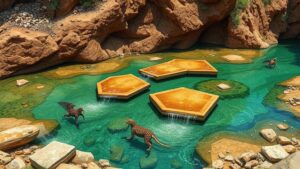The Mystery of Fossilized Waves: Ripple Marks Frozen in Ancient Shorelines
The Mystery of Fossilized Waves: Ripple Marks Frozen in Ancient Shorelines
For rockhounds and mineral collectors, the allure of fossilized waves, particularly ripple marks, provides not only aesthetic appeal but also a narrative woven into Earth’s geological history. These natural imprints, formed by the interplay of water and sediment, are fascinating markers that tell us about ancient environments and the dynamic processes that shaped them.
Understanding Ripple Marks
Ripple marks are small, wave-like formations that typically form on sandy or muddy surfaces due to the action of flowing water or wind. These structures can vary in size, with typical ripple wavelengths ranging from 1 cm to over 1 m. serve as evidence of past hydrodynamic conditions, allowing geologists and collectors to piece together the environmental conditions of ancient shorelines.
Types of Ripple Marks
There are two primary types of ripple marks that interest collectors:
- Symmetrical Ripple Marks: These are created by oscillating water movements, such as waves. They are often found in environments like beaches or tidal flats.
- Asymmetrical Ripple Marks: Formed by unidirectional water flow, these are typically associated with river beds and stronger currents.
Understanding these types can help collectors identify and appreciate the geological context of their finds.
Fossilization Process
The fossilization of ripple marks involves the preservation of sedimentary structures over geological time scales. This process typically occurs through lithification, where sediments compact and cement together, effectively freezing the ripple patterns into rock.
For example, in areas where ancient shorelines are exposed, ripple marks may be observed in sedimentary rocks such as sandstone or siltstone. preservation of these features can be influenced by factors like sediment supply, water flow dynamics, and the rate of burial.
Collecting Ripple Marks: Tips and Techniques
For rockhounds eager to collect specimens featuring ripple marks, here are key techniques to enhance your collection journey:
- Research Geological Formations: Start by identifying geological formations known for sedimentary rocks, particularly those formed in marine or fluvial environments.
- Use Tools Wisely: Equip yourself with basic geological tools such as a rock hammer, hand lens, and GPS device to gather and document your finds.
- Visit Natural Exposures: Look for road cuts, riverbanks, and beach bluffs where erosion has unveiled fossilized ripple marks.
- Protect Your Finds: Handle specimens carefully to avoid damaging fragile ripple displays, and store them in padded containers.
Real-World Applications and Significance
Beyond mere hobbyist interest, the study of ripple marks has broader implications for the scientific community. For example, understanding these structures aids in reconstructing paleoenvironmental conditions, which is crucial in fields like paleoclimatology and sedimentology. Also, ripple mark analysis can inform resource exploration, such as oil and gas reservoir characterization, as sedimentary structures influence fluid flow.
Conclusion: The Story of the Earth Beneath Our Feet
Fossilized waves and ripple marks are not just geological curiosities; they are solidified stories of Earths ancient landscapes and the forces that molded them. For collectors, unlocking the mystery of these features opens a window to millions of years of environmental history. By understanding their formation, types, and significance, rockhounds can deepen their appreciation for geology and the natural world.
Embarking on the quest for ripple mark specimens not only enriches ones collection but also connects collectors to the intricate tapestry of Earths geological past. As you explore, remember to respect the environments you investigate and document your finds responsibly.



